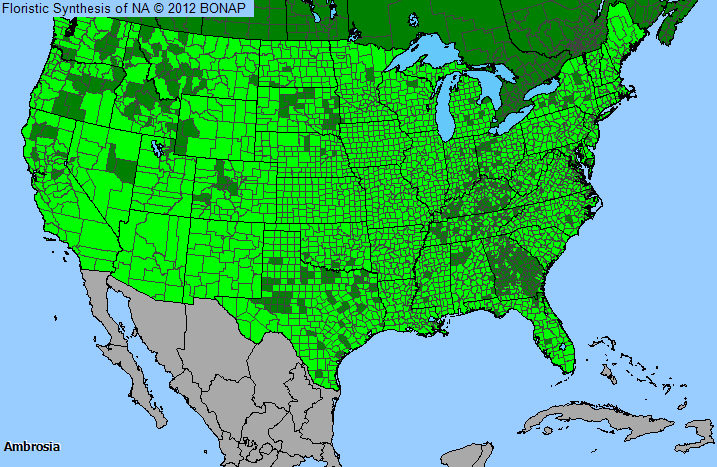
Plant Allergy Overview
Allergenicity
Severe
Pollen Season
Spring to Fall
Type
Weed
Sub-Type
Perennial
Allergy Information
Ragweed pollen is arguably the largest single seasonal allergen in North America. Also, skin contact may cause dermatitis.
Genus Details
About 17 widely-distributed species of ragweed are found in North America. Short (or common) ragweed has lacy and palmate leaves (with parts diverging from a common base, like the fingers of a hand). The flowers grow in a spike that extends vertically above the leaves. Ragweed heights range from a few inches to more than 12 feet. Giant ragweed grows from 12 to 18 feet tall in moist soils and has leaves with three lobes (hence its scientific name Ambrosia trifida). Common places to find ragweed plants are along the margins of agricultural fields, urban landscapes, along roadways, and near riverbanks that typically change during each spring snow melt and runoff. Flowering occurs late in the summer, since pollen development occurs when temperatures become lower than 60 degrees F. and the night length increases.
Pollen Description
The Ambrosia pollen grains are somewhat flattened to nearly spherical; the opercula slightly granular, and the ora lolongate to subcircular.The sexine is tectate; the largest spines with pointed apices and broad bases, sometimes with intermixed spinules, or occasionally with very short spinules interspersed with small piloid elements. The grains are very distinct. However, the pollen grains of Ambrosia trifida, Ambrosia artemisiifolia and Ambrosia psilostachya are indistinguishable to most pollen counting professionals. Therefore, in typical pollen count reports and forecasts, all ragweed types are combined into one category: ragweed.
Ambrosia pollen grains are 16-27 micrometers in diameter.
Genus Distribution

The shaded areas on the map indicates where the genus has been observed in the United States.
 - Native, observed in a county
- Native, observed in a county  - Introduced, observed in a county
- Introduced, observed in a county  - Rarely observed
- Rarely observedSpecies in Ragweed, Burr-ragweed Genus
Allergens & Plants Search
Enter a full or partial species name to find more information on one of over 1,200 potentially allergenic plants.
For example, you can find chenopods searching on "cheno"


